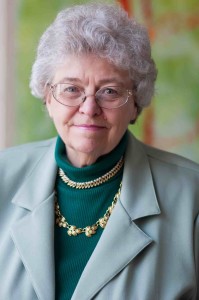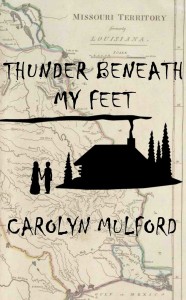 Relevant History welcomes former magazine editor and freelance writer Carolyn Mulford, who worked on five continents before making the transition to fiction. Thunder Beneath My Feet is her second middle grade/young adult historical novel. The Missouri Center for the Book selected the first, The Feedsack Dress, as the state’s Great Read at the 2009 National Book Festival. Show Me the Ashes, the fourth in her award-winning contemporary mystery series for adults, will be released in hardback and ebook on 16 March. To learn more about her and her books, visit her web site, and follow her on Facebook and Goodreads.
Relevant History welcomes former magazine editor and freelance writer Carolyn Mulford, who worked on five continents before making the transition to fiction. Thunder Beneath My Feet is her second middle grade/young adult historical novel. The Missouri Center for the Book selected the first, The Feedsack Dress, as the state’s Great Read at the 2009 National Book Festival. Show Me the Ashes, the fourth in her award-winning contemporary mystery series for adults, will be released in hardback and ebook on 16 March. To learn more about her and her books, visit her web site, and follow her on Facebook and Goodreads.
*****
The New Madrid earthquakes of 1811 and 1812 must have been part of my Missouri history class in grade school, but I’d forgotten about them by the time I wrote a reading comprehension exercise about the quakes for a textbook. Soon after I wrote a travel article featuring Tennessee’s 15,000-acre Reelfoot Lake, an overnight creation of the quakes.
Memories of those assignments resurfaced thirty years later when I was searching for a topic for my second middle grade/young adult historical novel. I’d loved reading historical novels since discovering Lucy Fitch Perkins in the third grade, and I wondered why I’d never seen a novel about three of the country’s most powerful earthquakes.
By the time I figured out the answer, I was committed to the project.
Just the facts
I began by reading everything I could find about the quakes. Opinions differed on whether three or five quakes occurred and whether they rated closer to 7.6 or 8.6 on the Richter scale. The latest and most official source, the U.S. Geological Survey, recognizes three big ones: 16 December 1811, 23 January 1812, and 7 February 1812.
Sources agree that Jared Brooks, a Louisville engineer, made the best contemporaneous measurements of the severity of the shocks (quakes) and shakes (aftershocks). He recorded 1,874 shocks, eight violent and ten very severe, over three months. His records of the shocks (and the weather) gave me a basic timeline. I filled it with fragmented accounts from residents and travelers. The title, Thunder Beneath My Feet, comes from one of those accounts.
No one can cite an exact number of deaths. Older books said about 100 people died. A recent source estimated 1,500. The disparity derives from neglecting to count Native Americans (the major inhabitants of the hardest hit area), slaves, and many who vanished in the Mississippi.
The river became deadly. It ran backwards, carrying flatboats upstream or capsizing them. Oceanic waves swamped canoes. Falls formed. Giant trees from the banks and dead ones dislodged from the river floor clogged the water. The water rose like a tide at night, forcing boaters to cut their moorings to avoid being dragged under.
In New Madrid, brick homes and chimneys crumbled. Log homes fared better, but many caught fire. Giant trees split up the middle. Sand boils erupted. Ravines appeared. Lakes formed and drained. Furrows resembling giant waves appeared in the fields. A stench rose from the eruption of rotted vegetation and gases. The shocks and shakes went on and on, sometimes around the clock, sometimes concentrated in one part of the day or night, always unpredictable.
I had the facts. They yielded no natural narrative line, no obvious heroes or villains, no dramatic climax, no happy ending. That’s why novelists had avoided the story. I spent weeks conceiving a satisfying plot.
Plus the people
Events become memorable when we see how they affect individuals. Obviously the quakes brought months of intermittent terror and constant misery to New Madrid. They also frightened people in most states, including Michigan, Pennsylvania, South Carolina, and Louisiana.
I focused my research on the 1,200 or so people in New Madrid, Upper Louisiana Territory—soon to become Missouri Territory. Positioned on a huge river bend roughly 200 miles south of St. Louis and 50 miles south of where the Ohio entered the Mississippi, the ambitious river port drew traders, suppliers, and the usual restless frontier folk. Some envisioned New Madrid competing with St. Louis.
The quakes took place eight years after the United States bought Louisiana from France, which had just acquired it from Spain. In the village’s broad streets and parks, people spoke English, Spanish, French, and Native American languages. Apparently the groups both objected to and adapted to each other’s ways.
One person’s trauma
Choosing a protagonist was easy. I preferred to relive the disaster with a teenage farm girl. Left in charge of her younger brother and the family farm outside New Madrid, she has no idea what’s happening when the first quake throws her out of bed. A French-Canadian identifies the disruptions as earthquakes but can’t explain what causes them or, more important, say when they will end. The sensible, courageous girl concentrates on food and shelter, on surviving the chaos. My childhood experiences on a pre-electricity farm and many visits to historic sites helped me figure out what she would do.
The odds are that no one there had ever experienced an earthquake. Some probably had heard that quakes toppled steeples in Boston in 1755. Certainly no one anywhere anticipated the diverse damage this series would cause and how long it would last.
By the third day, hundreds of people near the epicenter believed the world was ending. They fled from the flatlands to the nearest big hill, about a two-day walk, to escape anticipated floods and to pray for deliverance. A dark, dense, odiferous fog and occasional flashes of light coming from the ground make the teenager wonder if they could be right.
Circumstances compel her to remain on the farm, but she realizes she and her younger brother can’t stay alone. Their parents may have died in the quakes, and the nearest relatives live in eastern Kentucky. She takes in four newly homeless people—a French-Shawnee teenager, a young French-Spanish couple, and a mute slave woman. The story centers on how these six people respond to disasters and to each other.
As I worked on the manuscript, I realized that the frontier society’s problems foreshadowed the divisions that turned Missouri into hell during the Civil War and haunt it today.
Seismologists say that the earthquakes come in 200- and 500-year cycles. Human behavior appears to be a continuum. I can’t do anything about either, but I added earthquake damage to my home insurance policy.
*****
 A big thanks to Carolyn Mulford. She’ll give away a paperback copy of Thunder Beneath My Feet to someone who contributes a comment on my blog this week. I’ll choose the winner from among those who comment by Friday at 6 p.m. ET. Delivery is available in the U.S. only.
A big thanks to Carolyn Mulford. She’ll give away a paperback copy of Thunder Beneath My Feet to someone who contributes a comment on my blog this week. I’ll choose the winner from among those who comment by Friday at 6 p.m. ET. Delivery is available in the U.S. only.
**********
Did you like what you read? Learn about downloads, discounts, and special offers from Relevant History authors and Suzanne Adair. Subscribe to Suzanne’s free newsletter.

 Relevant History welcomes former magazine editor and freelance writer Carolyn Mulford, who worked on five continents before making the transition to fiction. Thunder Beneath My Feet is her second middle grade/young adult historical novel. The Missouri Center for the Book selected the first, The Feedsack Dress, as the state’s Great Read at the 2009 National Book Festival. Show Me the Ashes, the fourth in her award-winning contemporary mystery series for adults, will be released in hardback and ebook on 16 March. To learn more about her and her books, visit her
Relevant History welcomes former magazine editor and freelance writer Carolyn Mulford, who worked on five continents before making the transition to fiction. Thunder Beneath My Feet is her second middle grade/young adult historical novel. The Missouri Center for the Book selected the first, The Feedsack Dress, as the state’s Great Read at the 2009 National Book Festival. Show Me the Ashes, the fourth in her award-winning contemporary mystery series for adults, will be released in hardback and ebook on 16 March. To learn more about her and her books, visit her  A big thanks to Carolyn Mulford. She’ll give away a paperback copy of Thunder Beneath My Feet to someone who contributes a comment on my blog this week. I’ll choose the winner from among those who comment by Friday at 6 p.m. ET. Delivery is available in the U.S. only.
A big thanks to Carolyn Mulford. She’ll give away a paperback copy of Thunder Beneath My Feet to someone who contributes a comment on my blog this week. I’ll choose the winner from among those who comment by Friday at 6 p.m. ET. Delivery is available in the U.S. only.